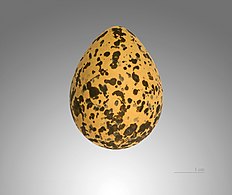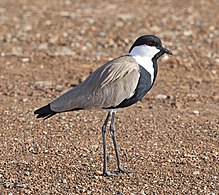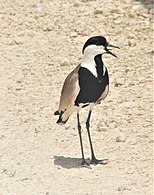| This article needs additional citations for verification. Please help improve this article by adding citations to reliable sources. Unsourced material may be challenged and removed. Find sources: "Spur-winged lapwing" – news · newspapers · books · scholar · JSTOR (February 2024) (Learn how and when to remove this message) |
| Spur-winged lapwing | |
|---|---|

| |
| Upper side of wings - note the spurs on the leading edge of the carpal joint | |
| Calls recorded at Lake Turkana, Kenya | |
| Conservation status | |
 Least Concern (IUCN 3.1) | |
| Scientific classification | |
| Domain: | Eukaryota |
| Kingdom: | Animalia |
| Phylum: | Chordata |
| Class: | Aves |
| Order: | Charadriiformes |
| Family: | Charadriidae |
| Genus: | Vanellus |
| Species: | V. spinosus |
| Binomial name | |
| Vanellus spinosus (Linnaeus, 1758) | |
| Synonyms | |
|
Charadrius spinosus Linnaeus, 1758 | |
The spur-winged lapwing or spur-winged plover (Vanellus spinosus) is a lapwing species, one of a group of largish waders in the family Charadriidae.
Taxonomy
The spur-winged lapwing was formally described in 1758 by the Swedish naturalist Carl Linnaeus in the tenth edition of his Systema Naturae. He placed it with the plovers in the genus Charadrius and coined the binomial name Charadrius spinosus. He specified the type locality as Egypt. The specific epithet is from Latin meaning "thorny" (from spina meaning "thorn"). Linnaeus based his account on a description by the Swedish naturalist Fredrik Hasselquist that had been published in 1757. The spur-winged lapwing is now one of 23 species placed in the genus Vanellus that was introduced in 1760 by the French naturalist Mathurin Jacques Brisson. The species is monotypic: no subspecies are recognised.
Description
These are conspicuous and unmistakable birds. They are medium-large waders with black crown, chest, foreneck stripe and tail. The face, the rest of the neck and belly are white and the wings and back are light brown. The bill and legs are black. Its striking appearance is supplemented by its noisy nature, with a loud did-he-do-it call. The bird's common name refers to a small claw or spur hidden in each of its wings.
Distribution
The spur-winged lapwing breeds around the eastern Mediterranean, and in a wide band from sub-Saharan west Africa to Arabia. The Greek and Turkish breeders are migratory, but other populations are resident. The species is declining in its northern range, but is abundant in much of tropical Africa, being seen at almost any wetland habitat in its range. The spur-winged lapwing is one of the species to which the Agreement on the Conservation of African-Eurasian Migratory Waterbirds applies.
In eastern and southern Africa the species has seen a range increase, entering Zambia for the first time in 1999 and spreading south and west.
Behaviour and ecology
This species has a preference for marshes and similar freshwater wetland habitats. The food of the spur-winged lapwing is insects and other invertebrates, which are picked from the ground.
It lays four blotchy yellowish eggs on a ground scrape. The spur-winged lapwing is known to sometimes use the wing-claws in an attack on animals and, rarely, people, who get too close to the birds' exposed offspring.
Supposed cleaning symbiosis
Main articles: Trochilus (crocodile bird) and Cleaning symbiosisThe "spur-winged plover" was identified by Henry Scherren as the "trochilus" bird said by the Greek historian Herodotus to be involved in what would now be called a cleaning symbiosis with the Nile crocodile. However, there is no reliable evidence that this or any other species in fact has such a relationship, although Cott does record that spur-winged plovers are the birds that most often feed around basking crocodiles, and are tolerated by them.
Gallery
-
 Egg in nest
Egg in nest
-
 Egg - MHNT
Egg - MHNT
-
 Chick
Chick
-
 Adult
Adult
-
 A spur-winged lapwing in the Gambia
A spur-winged lapwing in the Gambia
-
 Underside of wings
Underside of wings
-
 In Northern Israel, squawking at anyone or anything that came near its chick - showing its tongue.
In Northern Israel, squawking at anyone or anything that came near its chick - showing its tongue.
-
 In Northern Israel squawking at anyone (or anything) who came near its chick, which can be seen taking cover behind the tractor wheel.
In Northern Israel squawking at anyone (or anything) who came near its chick, which can be seen taking cover behind the tractor wheel.
References
- BirdLife International (2016). "Vanellus spinosus". IUCN Red List of Threatened Species. 2016: e.T22693983A86582288. doi:10.2305/IUCN.UK.2016-3.RLTS.T22693983A86582288.en. Retrieved 12 November 2021.
- Linnaeus, Carl (1758). Systema Naturae per regna tria naturae, secundum classes, ordines, genera, species, cum characteribus, differentiis, synonymis, locis (in Latin). Vol. 1 (10th ed.). Holmiae (Stockholm): Laurentii Salvii. p. 151.
- Peters, James Lee, ed. (1934). Check-List of Birds of the World. Vol. 2. Cambridge, Massachusetts: Harvard University Press. p. 241.
- Jobling, James A. (2010). The Helm Dictionary of Scientific Bird Names. London: Christopher Helm. p. 362. ISBN 978-1-4081-2501-4.
- Hasselquist, Fredrik (1757). Iter Palæstinum, eller Resa til Heliga Landet, förrättad ifrån år 1749 til 1752 : med beskrifnigar, rön, anmärkingar, öfver de märkvärdigaste naturalier, på Hennes Kongl. Maj.ts befallning (in Swedish and Latin). Vol. 1757. Stockholm: Trykt på L. Salvii kåstnad. pp. 260–261, No. 33.
- Gill, Frank; Donsker, David; Rasmussen, Pamela, eds. (December 2023). "Buttonquail, thick-knees, sheathbills, plovers, oystercatchers, stilts, painted-snipes, jacanas, Plains-wanderer, seedsnipes". IOC World Bird List Version 14.1. International Ornithologists' Union. Retrieved 9 February 2024.
- "Zambia". African Bird Club. 2017. Retrieved 16 April 2021.
- Herodotus. "The Histories of Herodotus". Book II: Euterpe. Ancient Worlds. pp. 2:68. Archived from the original on 19 July 2012. Retrieved 12 February 2012.
- Scherren, Henry (1906). Popular Natural History. Cassell. p. 268.
Mr. J.M. Cook, of the celebrated tourist agency, when in Egypt in 1876, "watched one of these birds, and saw it deliberately go up to a crocodile, apparently asleep, which opened its jaws. The bird hopped in, and the crocodile closed its jaws. In what appeared to be a very short time, probably not more than a minute or two, the crocodile opened its jaws, and we saw the bird go down to the water's edge." There were several of these birds about, and Mr. Cook shot two of them, which Dr. Sclater identified as Spur-winged Plovers; so that the question as to what bird enters the mouth of the crocodile is now set at rest.
- Macfarland, Craig G.; Reeder, W.G. (1974). "Cleaning symbiosis involving Galapagos tortoises and two species of Darwin's finches". Zeitschrift für Tierpsychologie. 34 (5): 464–483. doi:10.1111/j.1439-0310.1974.tb01816.x. PMID 4454774.
- Cott, H. B. (1961). Scientific results of an inquiry into the ecology and economic status of the Nile Crocodile (Crocodilus niloticus) in Uganda and Northern Rhodesia. Transactions of the Zoological Society of London, 29, 211-356.
External links
- BirdLife species factsheet for Vanellus spinosus
- "Vanellus spinosus". Avibase.

- "Spur-winged lapwing media". Internet Bird Collection.
- Spur-winged lapwing photo gallery at VIREO (Drexel University)
- Interactive range map of Vanellus spinosus at IUCN Red List maps
- Audio recordings of Spur-winged lapwing on Xeno-canto.